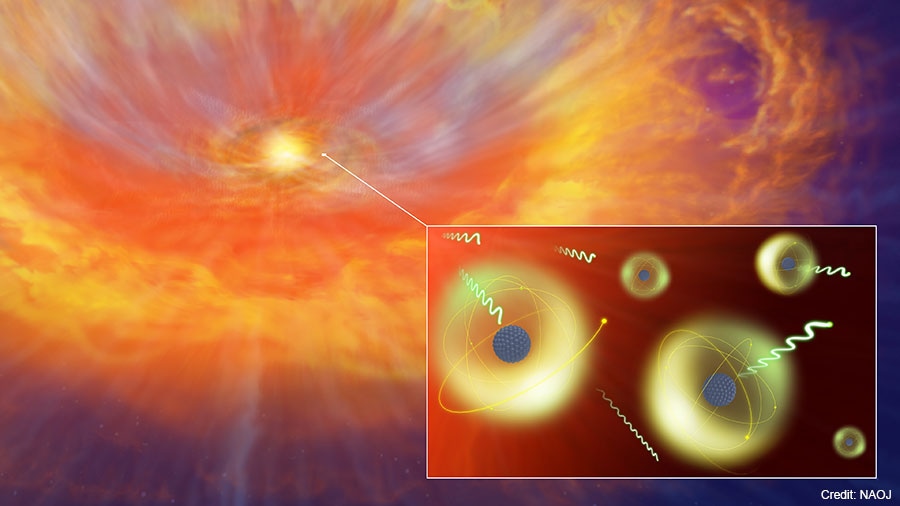Mar 13 2019
High-accuracy atomic data has been computed by a team of specialists in nuclear fusion and astronomy for studying light from a kilonova, a place of origin for heavy elements.
 Artist’s impression of a kilonova caused by a neutron star merger. In the material released by the merger, various heavy elements are formed, which then absorb and emit light. New atomic data calculations help to clarify kilonovae. (Image credit: National Astronomical Observatory of Japan)
Artist’s impression of a kilonova caused by a neutron star merger. In the material released by the merger, various heavy elements are formed, which then absorb and emit light. New atomic data calculations help to clarify kilonovae. (Image credit: National Astronomical Observatory of Japan)
These specialists studied that their new data set may be able to predict the brightness of kilonovae with enhanced precision than before. This indeed will help in the understanding of the cosmic origins of heavy elements.
Atoms and ions are capable of absorbing and emitting specific colors of light. By examining the colors of unapproachable objects, such as high-temperature plasmas present in a fusion chamber or faraway stars, scientists will be able to classify their elemental abundances. This study requires atomic data related to the wavelengths of light that each element absorbs and emits. However, there is no complete, precise atomic data for the heavy elements which are believed to be developed in kilonovae.
A research team headed by Daiji Kato, Associate Professor at the National Institute for Fusion Science (NIFS) in Japan, and Gediminas Gaigalas, Professor at Vilnius University in Lithuania, employed methods from nuclear fusion research to calculate millions of highly precise atomic data for neodymium ions. Neodymium is considered to be one of the vital elements for kilonovae radiation, and is studied in detail by simulations and experiments.
The atomic structure of neodymium is more complicated than those of lighter elements, such as iron, calculated for nuclear fusion science. We needed to extend and optimize our calculation methods for such an element with such complicated structures.
Daiji Kato, Associate Professor, National Institute for Fusion Science, Japan
When the collision of two neutron stars takes place, they end up breaking apart, emitting waves of unbalanced nuclear material into space. This material quickly decays leading to radioactive afterglow called a kilonova. Scientists assume that the nuclear reactions happening in neutron star mergers could possibly be one of the key sources for the heavy elements, including precious metals like platinum and gold, and rare earth metals like neodymium.
When compared to earlier calculations, the neodymium atomic data calculated by the Japan-Lithuania team were in agreement with the experimental data to a much better extent. Masaomi Tanaka, Associate Professor at Tohoku University, who is also an astronomer in the research group, succeeded in simulating the light of a kilonova with a supercomputer at the National Astronomical Observatory of Japan (NAOJ).
This was achieved using new atomic data, and for the very first time in the whole world, Tanaka was able to examine the influence of the database precision on the expected brightness of a kilonova. Furthermore, he discovered that the answer differed by about 20% at most, which is adequately precise to enable astronomers feel confident about their understanding of kilonova observations. The detailed abundances of cosmic heavy elements developed by kilonovae will soon be showcased by calculating atomic data for other metals using this method created in fusion science.
In February 2019, these study results were featured as Gaigalas et al. “Extended Calculations of Energy Level and Transition Rates of Nd II-IV Ions for Application to Neutron Star Mergers” in the Astrophysical Journal Supplement Series.